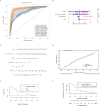Clinical characteristics of bronchopulmonary dysplasia and the risk of sepsis onset prediction via machine learning models
- PMID: 40656203
- PMCID: PMC12245775
- DOI: 10.3389/fped.2025.1566747
Clinical characteristics of bronchopulmonary dysplasia and the risk of sepsis onset prediction via machine learning models
Abstract
Bronchopulmonary dysplasia (BPD), also known as chronic lung disease, is the most common cause of respiratory morbidity in preterm infants. Sepsis plays a significant role in the pathogenesis of BPD, and the systemic inflammatory response caused by sepsis is associated with lung development, leading to simplified alveoli and abnormal vascular development, which are the histological hallmarks of BPD. In this study, we conducted a retrospective analysis of the clinical characteristics of 306 preterm infants with BPD treated at our hospital from December 2019 to December 2022. We subsequently utilized ten machine learning (ML) algorithms and used clinical features to acquire models to predict BPD with sepsis. The performance of the model was evaluated according to the mean area under the receiver operating characteristic curve (AUC), sensitivity, specificity, and accuracy. The mean area under the curve (AUC) of the best predictive model was 0.93. A nomogram for sepsis onset was developed in the primary cohort with four factors: invasive respiratory support, CRIB II score, NEC, and chorioamnionitis. By including clinical features, ML algorithms can predict BPD with sepsis, and the random forest (RF) model (sorted by the mean AUC) performs the best. Our prediction model and nomogram can help clinicians make early diagnoses and formulate better treatment plans for preterm infants with BPD.
Keywords: bronchopulmonary dysplasia; machine learning algorithms; nomogram; prediction model; sepsis.
© 2025 Wang, Wang, Song, Li, Xie, Yan, Hu and Feng.
Conflict of interest statement
The authors declare that the research was conducted in the absence of any commercial or financial relationships that could be construed as a potential conflict of interest.
Figures


References
LinkOut - more resources
Full Text Sources

